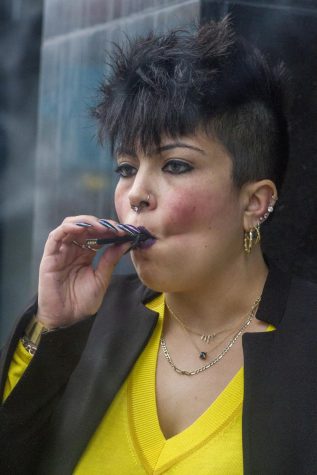Unicorn milk and young people: JUUL markets to the most vulnerable
May 9, 2019

JUUL, a brand of electronic cigarettes, has spent more than $1 million to market its products on Instagram, Twitter and YouTube, to target young people.
Colorful mango, cucumber, fruit and creme brûlée pods are snapped into JUUL devices and inhaled with short puffs of flavored smoke. These devices are hard to spot, designed to look more like school supplies than e-cigarettes, let alone the latest culprit of nicotine addiction among young people.
JUUL, a brand of electronic cigarettes, has spent more than $1 million to market its products on Instagram, Twitter and YouTube, featuring advertisements that associate smoking with popularity, sex appeal and fun. Although JUUL publicly announced the shut-down of its social media accounts in November 2018, its online presence remains through product placement, affiliate marketing campaigns and surrogates.
“We believe JUUL is the first viable alternative for adult smokers,” reads the JUUL website. “Those who don’t currently use nicotine products should not start. We recognize that smoking alternatives continue to be the subject of conversation. We welcome dialogue, debate, and data.”
One person often at the center of the debate is Kathy Drea, vice president of the American Lung Association of the Upper Midwest. She is quick to point out that e-cigarette use is considered a public–health crisis by the Food and Drug Administration, the Centers for Disease Control and Prevention and the surgeon general.
Drea does not believe teenagers are knowledgeable about the effects of nicotine on their lives.
When JUUL is used to limit the harm of smoking cigarettes by those who are already addicted and above the age of 25, it can be a healthier option than cigarettes, Drea said. However, she added that health impacts may be only slightly reduced in comparison with cigarettes because JUUL devices are much more addictive than cigarettes.
Social media and advertising are major contributors to the e-cigarette epidemic, according to Dr. Rebecca Good, a psychologist who works at an adolescent substance abuse treatment program.
“We are seeing famous people advertise [JUULs] in their Snapchat stories or in their Instagram posts,” Good said. “It is becoming a social phenomenon.”
Good added she has a hard time believing claims from JUUL CEO Kevin Burns that the products are not marketed toward young people because of how it is designed—easy for concealment.
More than 7 million high school students as of November 2018 use e-cigarettes, a 78% increase over the past year. Among middle schoolers, JUUL use rose 48% to 570,000 students, according to results released from the FDA’s annual national survey.
Freshman film major Giuliana Barrea began vaping in October 2018.
“[JUUL] is definitely marketed toward teenagers [and] younger people because of the different flavors,” Barrea said. “It is [advertised] as cool to vape and [have] smoke come out of your mouth, more so than cigarettes which smell bad and give you lung cancer and yellow teeth.”
Freshman exploratory major Jesse Alcauter started using JUUL because his friends used it when he hung out with them.
“So I got my own JUUL. Now I get pods every week,” Alcauter said. “Before I JUULed a lot when I’d hit it, I’d get the buzz and be kind of uncomfortable and feel nauseous almost. Now, after I’ve had a JUUL maybe a year and a half, it makes me feel really crappy some days.”
Alcauter said vaping does have a positive impact on people who are addicted to cigarettes and who are trying to switch to a less-harmful alternative.
Teenagers are more likely to use e-cigarettes than cigarettes, and 30.7% of e-cigarette users are more likely to become addicted to nicotine within six months of starting e-cigarette use, according to the National Institute on Drug Abuse.
The CDC found the flavors of JUUL pods are the primary reason adolescents are purchasing it.
“The impact JUUL has had on the market has been a huge part of the problem. Before that, the e-cigarette companies had 7,000 different flavors they use to attract mainly kids,” Drea said. “I heard this week one of the favorite flavors of kids is unicorn milk. The number of adults would be few and far between who would go in and buy something that was flavored a name like that.”
JUUL is becoming a commonality on middle school, high school and college campuses, despite the fact that the amount of nicotine contained in one JUUL pod is the same as that in an entire pack of cigarettes, Good said.
Illinois passed a law in April preventing anyone under 21 from buying cigarettes or tobacco products to eliminate the ability of 18-year-olds to buy tobacco and e-cigarettes and supply them to other high schoolers, Drea said.
“We were getting close to a tobacco-free generation; we really had almost eliminated [the] use of tobacco products,” Drea said. “It is so sad that we are starting all over, and with even stronger addictions than we had before.”






